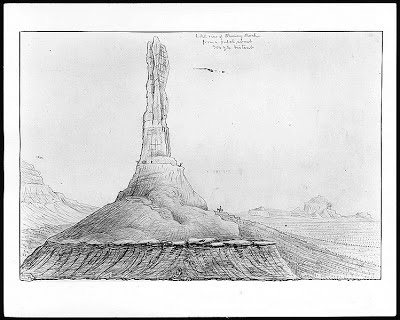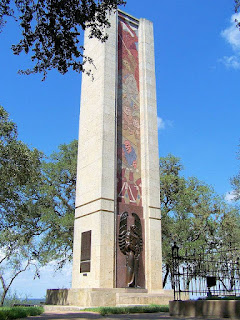Cush became a man about town, and his name and his works could
be seen in many homes in the region. He wrote for local publications, and his
thoughts were broadcast in every direction. He wrote for the local newspaper
and his best friends were the local elected officials...
When he died in 1888,
he was known as a popular, exceptionally gifted writer, poet, and artist.
A true pioneer hero, a trusted and respected friend of many of the "Who's- Who" of the American West, Major William Minor “Cush” Quesenbury
(pronounced cushionberry) was hired by P.
A. Smith as the first editor of the Navasota
Tablet, in 1869. He only lasted nine months here, and returned to his
beloved Arkansas. Who did you think I was talking about?
In 1976 my father Ralph
B. Cushman, also often nick-named “Cush,” was hired to oversee the
restoration of the old P. A. Smith Hotel,
a joint project of the Navasota Historical Society and the State of Texas. At
the time he was working on a manuscript about his childhood hero, Jesse Chisholm. The book was published
sixteen years later, but little did he ever know that one of Chisholm’s good
friends and associates had written the first editorials for the Tablet within
the walls of the old press room, next door on Railroad Street, (then the
property of the Navasota Examiner).And back then I was already working on the illustrations for that book, which helped launch my career as an historical illustrator and muralist. The cover illustration for the book hangs in Navasota City Hall. It is the scene of Chisholm chewing the fat with a Comanche chief, as Plains Indians put on a wild equestrian riding demonstration; something very similar to things Quesenbury saw with his own eyes.

A sketch by William Quesenbury
Hang with me, this is a good one!THE MURALIST
Monument Hill near La Grange. According to Wilbarger, it was Captain "Quisenberry" who brought the bones of 17 Texas heroes killed during the Mier Expedition to be buried there.
THE SOLDIER
According to the noted historian J. W. Wilbarger, Cush was assigned the proverbial "cush" job when fortune shined on young Captain "Quisenberry" and he was assigned the honor of escorting the long-lost bones of the Texans executed in the infamous "Drawing of the Black Bean" incident. These were the men who paid the ultimate price for the ill-fated Mier Expedition. This was just the kind of detail a man of his talent and character would have been assigned to, in this case by a victorious general and a future President of the United States.
Found by Major Walter P. Lane of the Texas Rangers during the Mexican War at Salado, Mexico, the dusty bones were exhumed and delivered to the headquarters of Commanding General Zachery Taylor, and the captain was dispatched to lead a caravan of wagons from there to La Grange, Texas where the final remains of seventeen Texian martyrs were re-interred, and eventually a grand monuent was erected at what we know today as Monument Hill.
THE JOURNALIST
He served once again in the service of his country, in the Confederacy, rising to the rank
of Major, using his extensive connections with the "Civilized Tribes" to serve as a Confederate Indian Agent. After the war he returned to civilian brilliance as editor of several
newspapers in Arkansas, until he was hired to come to the edge of the frontier
and start a newspaper… in Navasota, Texas.
Stabbed like a lance by the railroad, into the heart of Texas at the fork of the Brazos and the Navasota Rivers, the beleaguered village was a plethora of news, tradegies, outrages and scandals. But it was a short-lived adventure.
Navasota had just suffered two cataclysmic downtown fires in '65 and '68, which destroyed most of the town, and the charred crossroads village was still recoiling after a devastating Yellow Fever epidemic, which had killed or frightened away much of the decent folk. During all the chaos, there had been deadly race wars in the bottoms. The local planters had organized the Ku Klux Klan and lawlessness was the order of the day. Reporting factually on daily events would have been hazardous to your health.
By the Darwinian process we call "the survival of the fittest" Navasota had emerged from the Civil War as ribald frontier town, teaming with men "rough, passionate and full of wickedness," as their neighbor A. R. Kilpatrick, a local doctor described them. Gamblers, brawlers, hide traders, cut-throats and angry freedmen were invading the town and the streets were not safe at any hour of the day. It was a template for the western TV shows, like Deadwood, where hatred and guns were the law. Navasota was no place for a man of Quesenbury's caliber or status, especially to bring his family. In nine months, Quesenbury figured out what it took others a lifetime to figure out. He wisely returned to civilization.
Regrettably, most of Cush Quesenbury’s murals
were lost- burned or destroyed,
and only a few fairly mundane drawings survived, and were recently discovered
in an old trunk and have been compiled in a book. Without his epic story to provide context, and his colorful
murals, he became a dusty footnote in history. While researching him, I found a book review
that heartily trashed him as a contemptable drunk and racist, and it ticked me off. Then I found a fair and decent biography
about him, and lo, his own words inspired me…Stabbed like a lance by the railroad, into the heart of Texas at the fork of the Brazos and the Navasota Rivers, the beleaguered village was a plethora of news, tradegies, outrages and scandals. But it was a short-lived adventure.
Navasota had just suffered two cataclysmic downtown fires in '65 and '68, which destroyed most of the town, and the charred crossroads village was still recoiling after a devastating Yellow Fever epidemic, which had killed or frightened away much of the decent folk. During all the chaos, there had been deadly race wars in the bottoms. The local planters had organized the Ku Klux Klan and lawlessness was the order of the day. Reporting factually on daily events would have been hazardous to your health.
By the Darwinian process we call "the survival of the fittest" Navasota had emerged from the Civil War as ribald frontier town, teaming with men "rough, passionate and full of wickedness," as their neighbor A. R. Kilpatrick, a local doctor described them. Gamblers, brawlers, hide traders, cut-throats and angry freedmen were invading the town and the streets were not safe at any hour of the day. It was a template for the western TV shows, like Deadwood, where hatred and guns were the law. Navasota was no place for a man of Quesenbury's caliber or status, especially to bring his family. In nine months, Quesenbury figured out what it took others a lifetime to figure out. He wisely returned to civilization.
“Be not affronted by a jest: if a man
throws salt at thee, it will not hurt thee unless thou hast sore places.”
Sure I was sore… irresponsible rants and character assassination send a chill down my spine... The same writer would probably idolize and make heroes of Comanche warriors (also famous drunks and racists!) who relentlessly murdered defenseless groups or women and children...And yet Quesenbury's quips were like a salve... amazing how words can enrage, or touch… ring so true, between individuals who never met, yet know each other, as if cohabitating some kind of time/share machine.
Quesenbury’s good friend, the famed Southern leader, Albert Pike, no novice at writing, said
this of him:
“I do not know where he got his
command of language. No man ever wrote me such letters, so quaint and forcible,
so full of acute remarks and bold expressions of opinion, of exuberant
mirthfulness and queer fancies and grave reflections and sagacious axioms,
expressed in incomparable language.”
As these facts unfolded in
front of me… first from Dr Kilpatrick who by the way was a local doctor and writer,
and (coincidentally, distant kin of mine, and who took "Cush’s" place as editor at the Navasota
Tablet!) then from Hoig, the writer of
the “competition” Chisholm book which caused us great consternation back in the
‘90’s… (another story in itself) and then Wilbarger's Indian Depredations in Texas, and from the wonderful Internet which,
with some diligence peeled back the layers of the onion and revealed such a
fantastic historic jewel, I could not conceive all the coincidences and parallels
that had just happened, in the blink of
an eye. Almost scary!
One of Quesenbury's curious sketches...
Just a little nugget from God, saying, “there’s more where
that came from…”
















No comments:
Post a Comment